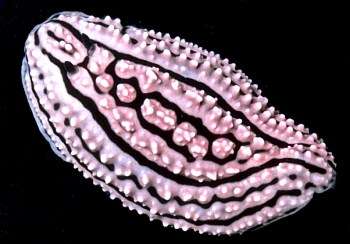
Phyllidiella zeylanica
(Kelaart, 1859)
Order: NUDIBRANCHIA
Suborder: DORIDINA
Superfamily: EUDORIDOIDEA
Family: Phyllidiidae
DISTRIBUTION
Restricted to the tropical Indian Ocean where it occurs from eastern Africa to Java.
PHOTO
UPPER RIGHT: 1 m depth, Phi Phi Island, southern Thailand, 24 Nov. 1989, dorsal view of 45 mm specimen (Brunckhorst, 1993: Plate 6F); LOWER LEFT: 4-10 m depth, Phi Phi Island, southern Thailand, 25 Nov. 1989, dorsal view of 24 mm specimen (Brunckhorst, 1993: Plate 6E); LOWER RIGHT: 8 m depth, Phi Phi Island, southern Thailand, 25 Nov. 1989, dorsal view of 15 and 40 mm specimens with egg mass of latter, on food sponge, Smenospongia sp. (Brunckhorst, 1993: Plate 6G).
Notes compiled from Brunckhorst, 1993:
Phyllidiella zeylanica is characterised by its numerous, very tuberculate, pink ridges which curve to join anteriorly and posteriorly (but may be interrupted), its pale foot sole, and its dark triangular oral tentacles. It differs from Phyllidiella pustulosa which does not possess ridges, and from Phyllidiella rosans which possesses relatively smooth rounded ridges (very tuberculate in P. zeylanica). For specimens of similar size, the rhinophoral clavus of P. zeylanica possesses fewer lamellae than P. rosans.
Reference:
• Brunckhorst, D.J. (1993) The systematics and phylogeny of Phyllidiid Nudibranchs (Doridoidea). Records of the Australian Museum, Supplement 16: 1-107.
PHOTOS: LOWER LEFT: 4-10 m depth, Phi Phi Island, southern Thailand, 25 Nov. 1989, dorsal view of 24 mm specimen (Brunckhorst, 1993: Plate 6E); LOWER RIGHT: 8 m depth, Phi Phi Island, southern Thailand, 25 Nov. 1989, dorsal view of 15 and 40 mm specimens with egg mass of latter, on food sponge, Smenospongia sp. (Brunckhorst, 1993: Plate 6G).
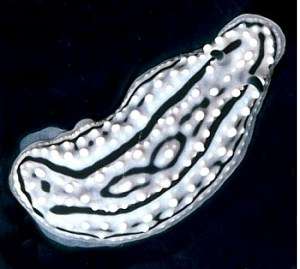
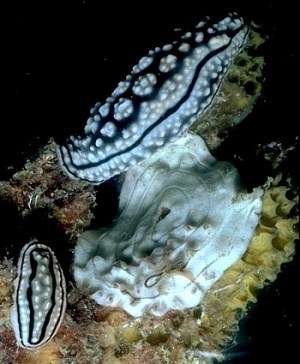
Rudman, W.B., 1999 (September 12) Phyllidiella zeylanica (Kelaart, 1859). [In] Sea Slug Forum. Australian Museum, Sydney. Available from http://www.seaslugforum.net/find/phylzeyl
Related messages
Re: Phyllidiella meandrina from Mayotte Island
November 27, 2009
From: Matthias Deuss
Concerning message #22766:
Dear Bill,
about the colours of Phyllidiella species, I totally agree and I would like to add that the two specimens of my earlier message, although appearing pink on the pictures, were in fact green-turquoise ! It is perhaps a defect of my cheap underwater camera, but I tried several manipulations including natural daylight and all the pictures were green.
Is it real pigments or some kind of light distorsion that colours those animals ?
Thanks,
Matthias Deuss
matthias976@hotmail.fr
Deuss, M., 2009 (Nov 27) Re: Phyllidiella meandrina from Mayotte Island. [Message in] Sea Slug Forum. Australian Museum, Sydney. Available from http://www.seaslugforum.net/find/22889Dear Matthias,
That's interesting. If your eyes thought they were green and the camera recorded them as green it could suggest a flash effect or some other physical factor but I have seen them in dish in the lab going from one to the other so I dont think its a simple light distortion affect. The other possibility is that it is something to do with their skin secretions but if so I have no idea how. I don't think anyone has researched this so it might be an interesting project for someone - certainly Phyllidiella can be extremely common so there would be no shortage of material to work on
Best wishes,
Bill Rudman
Phyllidiella meandrina from Mayotte Island
November 26, 2009
From: Matthias Deuss
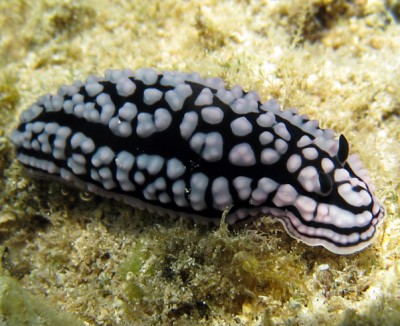
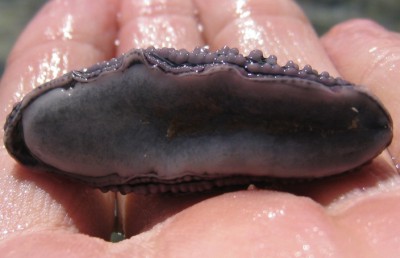
Dear Bill,
Here is a big specimen of Phyllidiella meandrina from Mayotte. I wanted to show it on the forum because it has a very peculiar appearance with its tubercles completely split up, which made me think until today that it was a Phyllidiella pustulosa. The second specimen, a smaller one, is more typical and was found on the same place.
Unfortunately, both were hiding from the sun at low tide under rocks so I didn't see them feeding.
Locality: Moutsoumbatsou reef, 0 m, Mayotte Island, Comoros, Indian Ocean, 20 August 2009, Intertidal rocky reef. Length: 50 & 30 mm. Photographer: Matthias Deuss.
Regards,
Matthias Deuss
matthias976@hotmail.fr
Deuss, M., 2009 (Nov 26) Phyllidiella meandrina from Mayotte Island. [Message in] Sea Slug Forum. Australian Museum, Sydney. Available from http://www.seaslugforum.net/find/22766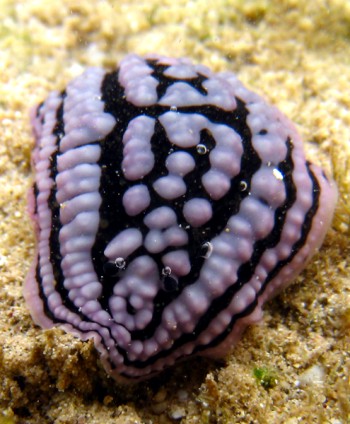
Dear Matthias,
I may be wrong but I consider this to be P. zeylanica. Have a look at my discussion on P. meandrina [message #8381]. There is always the possibility that there are not as many species as we think, but clearly a lot more work needs to be done, but I suspect until we look at local populations and their biology and natural history we won't be able to sort out inter- and intra-specific variation. Your animals certainly hint at the circular ridges of P. meandrina but I am not sure where we draw the line. It is a perfect example of the problems which still exist in identifying these species.
One point I should add. It seems all species of Phyllidiella can range from having a pink background to a grey green background. I dont think we can use pink or green as specific characters. I came to that conclusion once when collecting different coloured specimens of P. pustulosa to see of there were anatomical differences between pink and green animals. It was very frustrating when it came time to photograph and preserve each specimen to find that in the lab they had all turned to the same colour!
Best wishes,
Bill Rudman
Phyllidiella zeylanica from Mayotte Island
November 26, 2009
From: Matthias Deuss
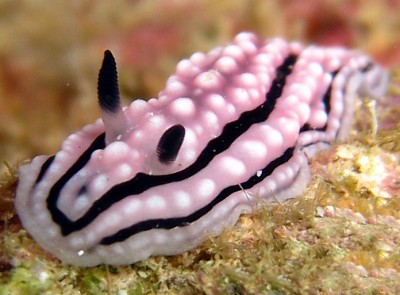
Dear Bill,
While reviewing my Phyllidiella pictures I found a slug that I think is P. rosans, since it has 14 or maybe 15 lamellae on the rhinophores (for a length superior to 30 mm). If indeed you agree it is P. rosans, then it is very hard to distinguish it from P. zeylanica by comparing the size of the tubercles !
Nonetheless, this variation with only one broad tuberculate longitudinal band on the dorsum is uncommon in Mayotte.
Locality: Passe en S, 5 metres, Mayotte Island, Comoros, Indian Ocean, 15 August 2009, Coral reef. Length: 30 mm. Photographer: Matthias Deuss.
Kind regards,
Matthias Deuss
matthias976@hotmail.fr
Deuss, M., 2009 (Nov 26) Phyllidiella zeylanica from Mayotte Island. [Message in] Sea Slug Forum. Australian Museum, Sydney. Available from http://www.seaslugforum.net/find/22779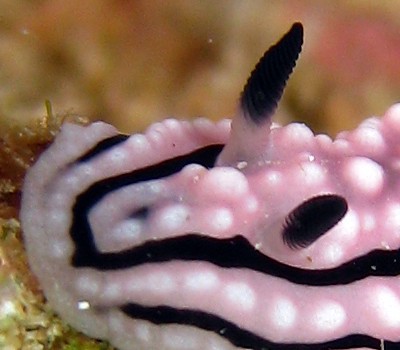
Dear Matthias,
I would consider this to be Phyllidiella zeylanica. I know that Brunckhorst states that P. zeylanica should have a few more rhinophore leaflets but I woud consider the highly nodulose ridges in your animals to be typical of P. zeylanica. In P. rosans the ridges are much smoother.
The species of Phyllidiella are difficult to differentiate and I suspect we still have some work to do. I am always suspicious of characters which rely on small differences such as these rhinophore leaflets - 20-23 lamellae in P. zeylanica (specimens greater than 30 mm), but only 12-15 in P. rosans. It gives little room for variability and no room for error in measuring the length of the specimens which stretch considerably when alive and contract to varying degrees when preserved. If one species has 5-6 rhinophore lamellae and another species 20-25, then that is a difference which has practical application, but unlike arthropods which apparently show remarkable precision in bristle numbers, I know of no studies on nudibranchs which give me confidence in using precise counts to separate species.
Best wishes,
Bill Rudman
Re: Phyllidiella zeylanica from Indian Ocean
March 11, 2009
From: Sandrine and Hugues Flodrops
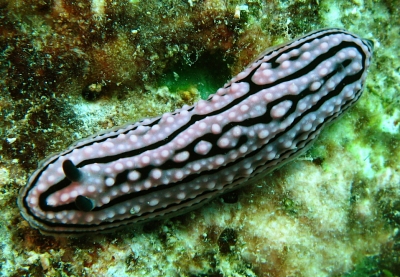
Concerning message #17730:
Dear Bill,
Always the same question between Phyllidiella zeylanica and P. rosans? I hope this time that we found our first P. zeylanica in Mayotte. The two specimens have compound tubercules, the only discussion is about the number of pink ridges. Is the number of pink ridges a good character to differentiate the two species? Up to nine in P. zeylanica and six to nine in P. rosans.
Locality: Upper photo: Pointe Barracuda "Passe en S". Mayotte. Indian Ocean. Depth: 18 metres. Specimen length: about 35 mm. 2 March 2009. Lower photo: Balcon sur le Bleu "Passe en S". Mayotte. Indian Ocean. Depth: 20 metres. Specimen length: 35 mm. 4 March 2009. Photographer: Hugues Flodrops.
Thanks for your expertise.
Regards.
Sandrine et Hugues.
hugues.flodrops@wanadoo.fr
Flodrops,S. H., 2009 (Mar 11) Re: Phyllidiella zeylanica from Indian Ocean. [Message in] Sea Slug Forum. Australian Museum, Sydney. Available from http://www.seaslugforum.net/find/22321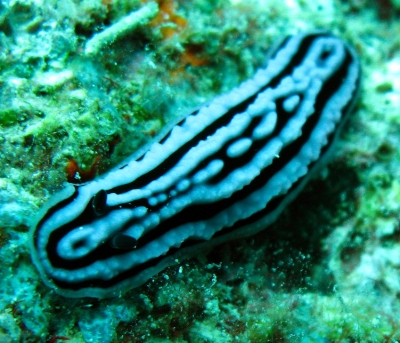
Dear Sandrine and Hugues,
According to David Brunckhorst, The main way to differentiate these two species externally is not the number of ridges but whether the ridges are smooth or not. In P. zeylanica the ridges are usually rough and nodulose, as in your two animals, while in P. rosans the ridges are relatively smooth with no real sign of underlying pustules. Another external character is that the foot of P. zeylanica is whitish and its gills and oral tentacles are dark grey while in P. rosans all the underside is pale grey.
David Brunckhorst's review was the result of a diligent and exhaustive study of both existing collections and material that he collected from a wide variety of localities. However no taxonomic work is ever totally complete, and one way of testing taxonomic decisions is to study large populations of animals at particular places. You are developing a good knowledge of your local population. If your experience suggests that P. zeylanica and P. rosans are just extreme forms of the same species then let us know. Do Brunckhorst's ventral colour differences agree with your observations? Have you found intermediates between the two species? Local experience can be of great value in showing us where taxonomic problems still exist.
Best wishes,
Bill Rudman
Size differences in mating Phyllidiella zeylanica
August 30, 2007
From: Colin Ogden
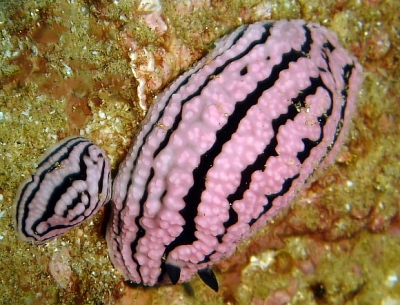
Hi Bill,
On a dive today I came across these 2 Phyllidiella? that appear to be mating. I am amazed to see the difference in size. They also both seem to be covered in little bugs. I know you have mentioned their name before, but I can't remember it. Are they parasites, hitchhikers or cleaners.
Can you also please identify the nudi's. I get confused by the P. zeylanica vs P. meandrina vs Phyllidiopsis gemmata.
Locality: Sodwana Bay, 12 meters, South Africa, Indian, 26 august 2007, reef. Length: 55mm & 15mm. Photographer: Colin Ogden.
Thanks so much for your help.
Regards
Colin
scubaco@iafrica.com
Ogden C.M., 2007 (Aug 30) Size differences in mating Phyllidiella zeylanica . [Message in] Sea Slug Forum. Australian Museum, Sydney. Available from http://www.seaslugforum.net/find/20567Dear Colin,
These are Phyllidiella zeylanica. Their size difference is certainly at the extreme end of possibilities. In most nudibranchs the male system develops first so small males are able to produce and transfer sperm quite early in their development. We don't know a lot about breeding but it is possible that a small animal like this could store sperm from a partner for some weeks unitl it ovary developed - but that all supposes that the special sperm sacs it has to store its partner's sperm are developed and functional at this small size.
Concerning the 'bugs' on the phyllidiids. I can't see them clearly in your photos but I guess they are some small crustacea.
Best wishes,
Bill Rudman
Phyllidiella zeylanica from Jakarta
February 7, 2007
From: Charles Rowe
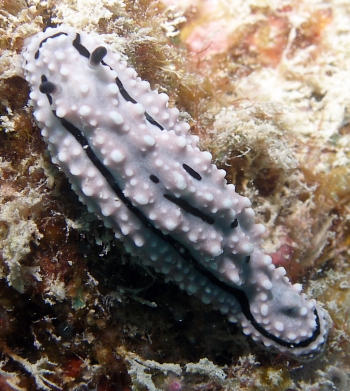
Concerning message #18378:
Hi Bill,
This is the second of my unidentified nudis from Sepa Island. It looks similar to Phyllidiopsis krempfi but that species has transverse black stripes whereas this one doesn't. Is it a different species?
Locality: Sepa Island, One thousand Islands near Jakarta, 15 metres, Indonesia, Ocean, 11 September 2006, Reef slope in debris. Photographer: Charles Rowe.
Charles Rowe
bumff@mweb.co.za
Charles Rowe, 2007 (Feb 7) Phyllidiella zeylanica from Jakarta. [Message in] Sea Slug Forum. Australian Museum, Sydney. Available from http://www.seaslugforum.net/find/18519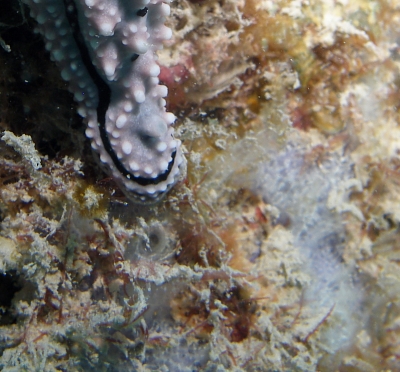
Dear Charles,
I am pretty sure this is Phyllidiella zeylanica. The distinct ridges distinguish this from many of the similar looking species. I have included a close-up of part of your photo showing what looks like a partially eaten colony of a greyish sponge. I can't be sure if it has anything to do with the nudibranch, but by building up possible feeding records like this we can gradually, I hope, be able to distinguish feeding records from coincidences.
Best wishes,
Bill Rudman
Phyllidiella zeylanica feeding
October 6, 2005
From: Lindsay Warren
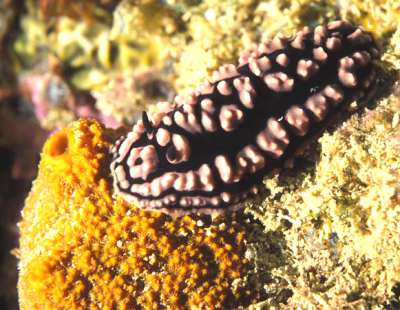
Dear Bill
Here is the second of the two feeding opisthos from Madagascar - a Phyllidiella pustulosa which in no way wanted to be moved from this 'restaurant'. It and the sponge were on one of several small coral heads which lie to the east of the very small island of Nosy Toloho. We just managed to get a dive in before a heavy squall forced us to leave the area and head back to the mainland near Nosy Bé.
Locality: Nosy Toloho, Iles Mitsio, NW Madagascar, Indian Ocean.
Depth: 22 ft. Length: 42 mm. 23 January 2002. Shallow sandy area surrounding small island with scattered coral heads / bommies and seagrass
Photographer: Lindsay Warren
As with the Chromodoris africana [message #14894 ], I also do not know what species of sponge it is feeding on. Hopefully someone will be able to hazard a good guess.
All the best
Lindsay
lwarren@datonomy.co.uk
Warren, L.C.R., 2005 (Oct 6) Phyllidiella zeylanica feeding. [Message in] Sea Slug Forum. Australian Museum, Sydney. Available from http://www.seaslugforum.net/find/14895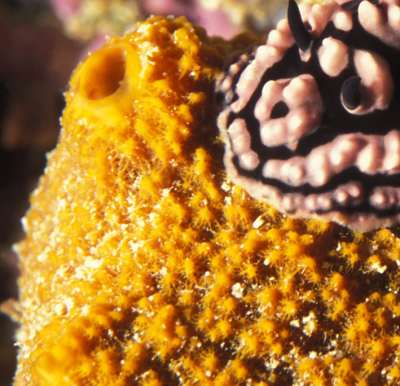
Dear Lindsay,
I am pretty sure this is Phyllidiella zeylanica rather than P. pustulosa. The double pink margin around the mantle edge, and the tubercles arranged in rows are characteristic of P. zeylanica. Brunckhorst reports this species feeding on Smenospongia sp. but I I will need to get this photo of yours checked to see if this sponge is possibly the same
Best wishes,
Bill Rudman
Phyllidiella zeylanica from Pemba
November 23, 2002
From: Paul Young
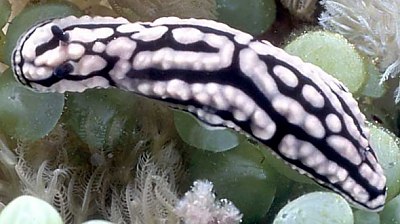
Dear Bill,
Here is one of the nudibranchs that Charlotte and I found at Pemba Island, off the coast of Tanzania, western Indian Ocean, in November/December 2001. The species was photographed on the 29 November, on the east side of Pemba
Best wishes,
Paul Young
young@underwater.org
Young, P., 2002 (Nov 23) Phyllidiella zeylanica from Pemba. [Message in] Sea Slug Forum. Australian Museum, Sydney. Available from http://www.seaslugforum.net/find/8422Thanks Paul,
This certainly looks like Phyllidiella zeylanica. It has black rhinophores, and the arrangement of black lines looks fairy typical for the species. I have kept this separate from the other phyllidiid you have sent a photo of because I have some doubts about that animal's identity
Best wishes,
Bill Rudman
Phyllidiella zeylanica? from Pemba
November 22, 2002
From: Paul Young
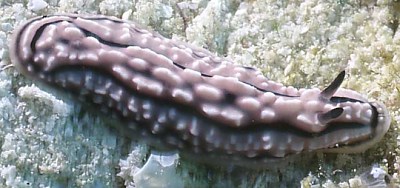
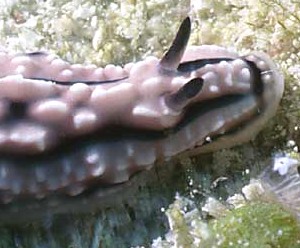
Dear Bill,
Here is one of the nudibranchs that Charlotte and I found at Pemba Island, off the coast of Tanzania, western Indian Ocean, in November/December 2001. The species from the west coast of Pemba are from dives we did with the Fundu Lagoon Resort to small nearby islands.
Image Data: Seen 22, 23, 27 November, near Fundu Lagoon, West side of Pemba.
Best wishes,
Paul Young
young@underwater.org
Young, P., 2002 (Nov 22) Phyllidiella zeylanica? from Pemba. [Message in] Sea Slug Forum. Australian Museum, Sydney. Available from http://www.seaslugforum.net/find/8420Thanks Paul,
I assume this is Phyllidiella zeylanica [a juvenile perhaps?], although the longitudinal ridges are very broken. One other doubt I have is caused by the colour of the rhinophores. In this species the rhiophores are described as 'black' by Brunckhorst, yet these look more like a species of Phyllidiopsis with the base and the from of the rhinophore being pinkish.
Best wishes,
Bill Rudman
Phyllidiella zeylanica from South Africa
September 16, 2002
From: Linda Penny
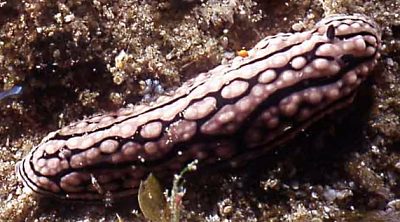
Dear Dr Rudman.
This photo was taken by Laurette Hanekom in Sodwana on the northen coast of Kwa-Zulu Natal in South Africa. I presume it is Phyllidia something but can't seem to find a close match on the Forum. Could you identify it please.
Many thanks
Linda
lindapenny@netactive.co.za
Penny, L., 2002 (Sep 16) Phyllidiella zeylanica from South Africa. [Message in] Sea Slug Forum. Australian Museum, Sydney. Available from http://www.seaslugforum.net/find/7870Dear Linda,
These grey and black phyllidiids are not easy to distinguish. This is Phyllidiella zeylanica.
Best wishes,
Bill Rudman
Phyllidiella zeylanica? from east Africa
July 2, 2002
From: Bernard Picton
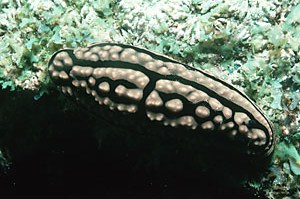
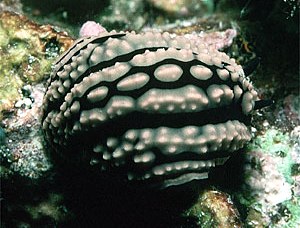
Hi Bill,
To accompany the photo of Phyllidiella rosans here are some photos which may be Phyllidiella zeylanica. They were collected at the same time from Pemba Island, east Africa in Feb 1999.
This is the most common phyllidiid in the area (~30mm). It may be fully grown Phyllidiella rosans - but most of the pictures of P. rosans seem to show no cross-bars of black, only longitudinal bars. The tubercles seem to be too low for P. zeylanica but more separate than P. rosans.
Bernard
bernard.picton.um@nics.gov.uk
Picton, B., 2002 (Jul 2) Phyllidiella zeylanica? from east Africa. [Message in] Sea Slug Forum. Australian Museum, Sydney. Available from http://www.seaslugforum.net/find/6469Thanks Bernard,
If we go on published information then these are fairly typical P. zeylanica. What of course would be inetersting to know is whether they feed on the same sponge as you have photographed P. rosans on. Hopefully we can gradually build up some more clues as to the just what constitutes as species in this group.
Cheers,
Bill Rudman
Phyllidiella zeylanica from Comoros
June 30, 2002
From: Valeria Safonova
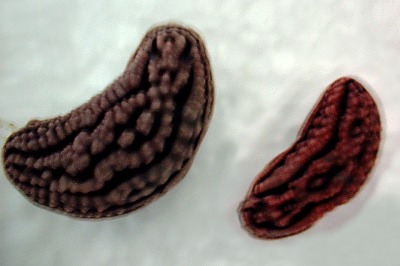
Dear Bill,
Thank you that you answered my question about the Spanish Dancer. Here are two photos of Phyllidia rosans but I'm not sure that they are of the same species because of their different colours - pink and grey.
Regards from Comoros
Valeria
vailulu@hotmail.com
Safonova, V., 2002 (Jun 30) Phyllidiella zeylanica from Comoros. [Message in] Sea Slug Forum. Australian Museum, Sydney. Available from http://www.seaslugforum.net/find/7362Dear Valeria,
I am pretty sure this is Phyllidiella zeylanica. It looks very like the common Phyllidiella pustulosa but differs in having the tubercles arranged in longitudinal ridges. It also has similarities to Phyllidiella rosans but in that species the ridges are relatively smooth while in P. zeylanica they are clearly pustulose.
Concerning the colour differences, most species of Phyllidiella show a range in background colour from grey to green to pink.
Cheers,
Bill Rudman
Phyllidiella zeylanica from Christmas Island
June 30, 2002
From: Bill Rudman

Here are some more photos of Phyllidiella zeylanica from John Hicks' Christmas Island, Indian Ocean collections. Considering the confusion surrounding some of these species I think it is useful to document some of the variation.
PHOTOS:
UPPER RIGHT: AM C126499, 2m, 11 November 1980, Christmas Is.
LOWER RIGHT & LEFT: AM C126497, 10 November 1980, 9m, on coral rocks, North Arm, Cantilever, Christmas Is. Photos: John Hicks
Best wishes,
Bill Rudman


Phyllidiella zeylanica from Christmas Island
May 13, 2002
From: W.B. Rudman

Here is some information and photos on Phyllidiella zeylanica from John Hicks' Christmas Island, Indian Ocean collections.
PHOTOS:
• Upper Right, Lower Right: AM C126502, 22 mm long alive, 13 November 1980, south arm of Cantilever, 7.5m, on coral rock, Christmas Is.
• Lower Left: AM C126509, 20 mm long alive, 15 November 1980, Christmas Is.
Photos: John Hicks
Best wishes,
Bill Rudman
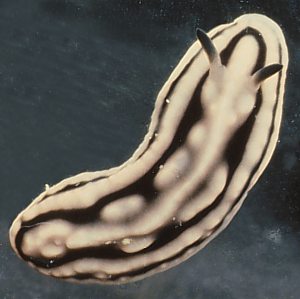
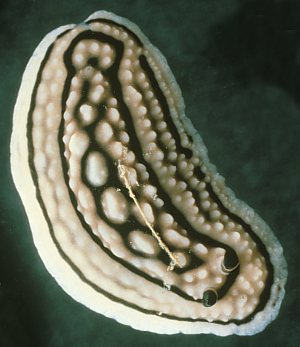
More pesky Phyllidiids
January 15, 2002
From: Mary Jane Adams
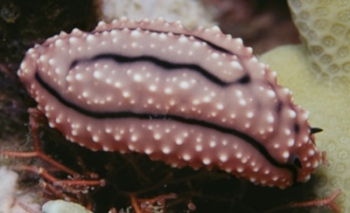
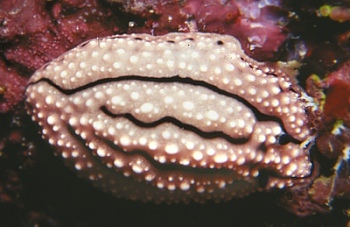
Hi Bill,
Here are a couple of Phyllidiids that don't seem to be typical of any known species. They are similar to some I previously sent you that you put on the Phyllidiella zeylanica page.
Upper Photo: I found this on a patch reef in Bootless Bay, Papua New Guinea.
Lower Photo: from Mary Island, Solomon Islands.
I know you need a specimen to be sure, but perhaps P. zeylanica has a wider distribution than previously thought.
Best regards,
Mary Jane
divepng@yahoo.com
Adams, MJ. , 2002 (Jan 15) More pesky Phyllidiids. [Message in] Sea Slug Forum. Australian Museum, Sydney. Available from http://www.seaslugforum.net/find/5935Dear Mary Jane,
It's very likely that many of these species have a wider distribution than we at present know. I think you are correct in identifying this with P. zeylanica. Your animal also has similarities to Phyllidiopsis gemmata but that species doesn't have a submarginal black line around the mantle edge. "Pesky' is a very American word, but it certainly is a good one for these phyllidiids.
Best wishes,
Bill Rudman
Opposites attract even with nudibranchs
October 3, 2001
From: Valda Fraser
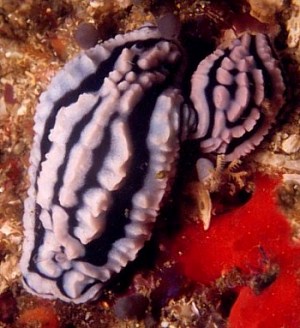
Dear Bill
The big Phyllidiella zeylanica selected this small lover. Can't imagine why because there were plenty of large ones about! I thought size would count!
Locality: Park Rynie, south coast KwaZulu-Natal, 25m
Date: September 2001
Regards
Valda
valdafraser@mweb.co.za
Fraser, V., 2001 (Oct 3) Opposites attract even with nudibranchs. [Message in] Sea Slug Forum. Australian Museum, Sydney. Available from http://www.seaslugforum.net/find/5356Dear Valda,
I guess the simple answer is that in these animals 'love is blind'. Basically opisthobranchs are blind. Although they have eyes, they are so simple in construction that they are unable to form images and basically act as light detectors. So body size, and colour, are of little consequence in mate selection. Opisthobranchs seem to operate by smell using chemical detectors (rhinophores etc) and touch (oral tentacles etc). It seems that mate detection can involve the chance discovery of mucus trails but mates are normally discovered by chance 'bumping into each other'. In many species the male organ system matures long before the female system (protandry) so in a case like your phyllidiids it is possible that the smaller may act only as a sperm donor in this exchange. It is also possible that it may receive sperm from its larger partner and store in a sperm sac until its own eggs develop, but this is only speculation as few detailed studies on the function of opisthobranch reproductive systems have been undertaken.
Best wishes,
Bill Rudman
Phyllidiella zeylanica? from the Maldives
May 27, 2001
From: Erwin Koehler
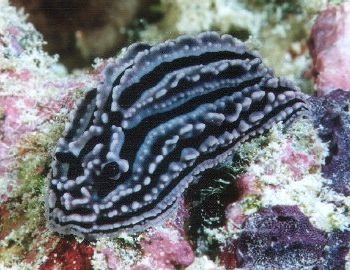
Dear Bill,
Attached is a photo from the Maldives, Kandooma Fushi Island, divesite "Kandooma Out", length 43mm, depth 21m, Sept. 17, 2000.
It looks like a bit like Phyllidiella rosans (but is much larger than Brunckhorst writes) and a little bit like Phyllidiella zeylanica
Erwin
Erwin@medslugs.de
Koehler, E., 2001 (May 27) Phyllidiella zeylanica? from the Maldives. [Message in] Sea Slug Forum. Australian Museum, Sydney. Available from http://www.seaslugforum.net/find/4222Dear Erwin,
I am sure it will become easier to identify these phyllidiids some time in the future but at present some are indeed a puzzle especially when only a photo is available.
Considering its size and the very tuberculate ridges, I would guess that this is Phyllidiella zeylanica. Comments on any of my identifications are always welcome.
Best wishes,
Bill Rudman
Phyllidiella zeylanica from Indonesia
December 31, 2000
From: Yasman
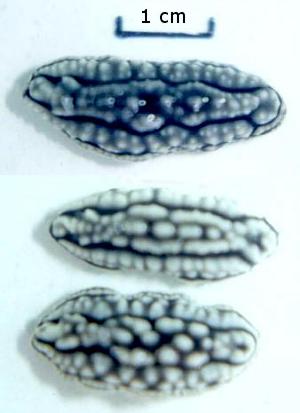
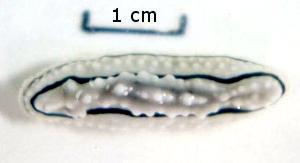
Dear Bill,
Again, I send you some photos of a species I found in Karang Lebar Atoll, Thousand Island, Indonesia. I am very sure that the bottom picture is Phyllidiella zeylanica. But I am not sure if the rest also belong to the same species. What do you think??
Thank you very much.
Regards,
Yasman
y.yasman@mailcity.com
Yasman, 2000 (Dec 31) Phyllidiella zeylanica from Indonesia. [Message in] Sea Slug Forum. Australian Museum, Sydney. Available from http://www.seaslugforum.net/find/3338Dear Yasman,
I am pretty sure that all these photos are of P. zeylanica.
Best wishes,
Bill Rudman.
Phyllidiella zeylanica from Papua New Guinea?
June 7, 2000
From: Mary Jane Adams
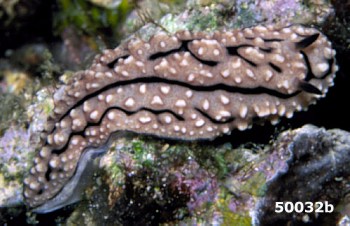
Dear Bill,
Here are photos of two slugs that are very similar to the Phyllidiella cf rudmani I sent you previously. Both animals are pinkish beige with multiple single lighter colored tubercles. The pattern of black lines is also very similar.
The rhinophores are black with a band of light pink at the base.
The slug in # 50032a and # 50032b was found in a coral rubble patch on a reef on the north side or the northern arm of Milne Bay, PNG. Length, 40 mm, Depth, 10 meters. May 25, 2000.
The slug in #119735 was crawling over hard coral on a reef in the Russell group of the Solomon Islands Nov. 11, 1997. Length about 35 mm, depth unrecorded.
Since these three slugs are so much alike and were found at different sites, it makes me wonder they are a separate species rather than atypical Phyllidiella rudmani. What do you think?
Regards,
Mary Jane
mjdams@earthlink.net
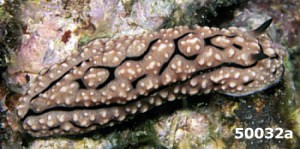
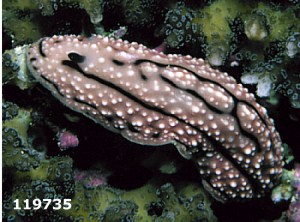
Dear Mary Jane,
The problem with Phyllidiella rudmani and Phyllidiella lizae, (which has diagonal black cross patterns like these photos), is that their rhinophore clubs are black and pink whereas in these photos the club is black although the stalk may be pink. I suspect that the three earlier photos may represent more than one species.
One species these latest photos are very similar to in external appearance is Phyllidiella zeylanica which does have black rhinophores. However at present it is only known from the Indian Ocean. If your animals are this species then it will the first record from the Pacific. I must admit though that some of the Phyllidiella group are proving to be rather problematical.
Best wishes,
Bill Rudman.
Phyllidiella zeylanica from Sth Africa
March 30, 2000
From: Valda Fraser
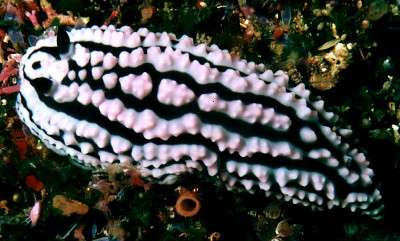
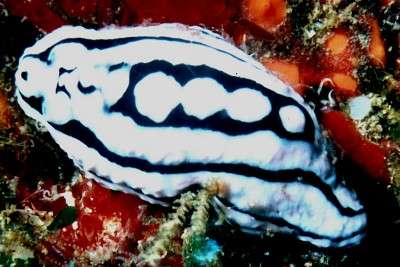
Dear Bill
Please look at these two photos. I think that are both Phyllidiella zeylanica. Your comment would be appreciated.
Locality: South coast KwaZulu-Natal SOUTH AFRICA
UPPER: Scottburgh - 25m, November 1999, 45mm long.
LOWER: Park Rynie - 25m, March 2000, 40mm long
Regards
Valda Fraser
iti04937@mweb.co.za
Fraser, V., 2000 (Mar 30) Phyllidiella zeylanica from Sth Africa. [Message in] Sea Slug Forum. Australian Museum, Sydney. Available from http://www.seaslugforum.net/find/2162Dear Valda,
Yes these are Phyllidiella zeylanica.
Best wishes,
Bill Rudman.
Is this Phyllidiella zeylanica?
December 14, 1999
From: Erwin Koehler
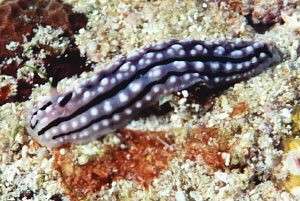
Bill,
One more Phyllidiid from the Maldives, Phyllidiella zeylanica or Phyllidiella rudmani or something esle?
Data: Guraidhoo Is., divesite "Guraidho Kandu", date Oct. 24, 1999, size 33 mm, depth 23 m.
Erwin
Medslugs.Koehler@t-online.de
Koehler, E., 1999 (Dec 14) Is this Phyllidiella zeylanica?. [Message in] Sea Slug Forum. Australian Museum, Sydney. Available from http://www.seaslugforum.net/find/1602Dear Erwin,
I think this is P. zeylanica but I am afraid the angle of the photo makes its difficult to be sure. I am not sure of the tubercle and ridge pattern in the middle part of the dorsum behind the rhinophores and so don't have a good idea of the pattern which Brunckhorst considered very important.
Best wishes,
Bill Rudman.
